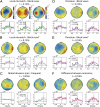Evidence for a hierarchy of predictions and prediction errors in human cortex
- PMID: 22147913
- PMCID: PMC3251061
- DOI: 10.1073/pnas.1117807108
Evidence for a hierarchy of predictions and prediction errors in human cortex
Abstract
According to hierarchical predictive coding models, the cortex constantly generates predictions of incoming stimuli at multiple levels of processing. Responses to auditory mismatches and omissions are interpreted as reflecting the prediction error when these predictions are violated. An alternative interpretation, however, is that neurons passively adapt to repeated stimuli. We separated these alternative interpretations by designing a hierarchical auditory novelty paradigm and recording human EEG and magnetoencephalographic (MEG) responses to mismatching or omitted stimuli. In the crucial condition, participants listened to frequent series of four identical tones followed by a fifth different tone, which generates a mismatch response. Because this response itself is frequent and expected, the hierarchical predictive coding hypothesis suggests that it should be cancelled out by a higher-order prediction. Three consequences ensue. First, the mismatch response should be larger when it is unexpected than when it is expected. Second, a perfectly monotonic sequence of five identical tones should now elicit a higher-order novelty response. Third, omitting the fifth tone should reveal the brain's hierarchical predictions. The rationale here is that, when a deviant tone is expected, its omission represents a violation of two expectations: a local prediction of a tone plus a hierarchically higher expectation of its deviancy. Thus, such an omission should induce a greater prediction error than when a standard tone is expected. Simultaneous EEE- magnetoencephalographic recordings verify those predictions and thus strongly support the predictive coding hypothesis. Higher-order predictions appear to be generated in multiple areas of frontal and associative cortices.
Conflict of interest statement
The authors declare no conflict of interest.
Figures



Similar articles
-
Silent Expectations: Dynamic Causal Modeling of Cortical Prediction and Attention to Sounds That Weren't.J Neurosci. 2016 Aug 10;36(32):8305-16. doi: 10.1523/JNEUROSCI.1125-16.2016. J Neurosci. 2016. PMID: 27511005 Free PMC article.
-
Responses of human auditory association cortex to the omission of an expected acoustic event.Neuroimage. 2001 Jun;13(6 Pt 1):1073-89. doi: 10.1006/nimg.2001.0766. Neuroimage. 2001. PMID: 11352613
-
The sound of silence: Predictive error responses to unexpected sound omission in adults.Eur J Neurosci. 2022 Apr;55(8):1972-1985. doi: 10.1111/ejn.15660. Epub 2022 Apr 17. Eur J Neurosci. 2022. PMID: 35357048
-
Adjudicating Between Local and Global Architectures of Predictive Processing in the Subcortical Auditory Pathway.Front Neural Circuits. 2021 Mar 12;15:644743. doi: 10.3389/fncir.2021.644743. eCollection 2021. Front Neural Circuits. 2021. PMID: 33776657 Free PMC article. Review.
-
Explaining the high voice superiority effect in polyphonic music: evidence from cortical evoked potentials and peripheral auditory models.Hear Res. 2014 Feb;308:60-70. doi: 10.1016/j.heares.2013.07.014. Epub 2013 Aug 3. Hear Res. 2014. PMID: 23916754 Review.
Cited by
-
A quantitative model reveals a frequency ordering of prediction and prediction-error signals in the human brain.Commun Biol. 2022 Oct 10;5(1):1076. doi: 10.1038/s42003-022-04049-6. Commun Biol. 2022. PMID: 36216885 Free PMC article.
-
Multiple Concurrent Predictions Inform Prediction Error in the Human Auditory Pathway.J Neurosci. 2024 Jan 3;44(1):e2219222023. doi: 10.1523/JNEUROSCI.2219-22.2023. J Neurosci. 2024. PMID: 37949655 Free PMC article.
-
Content-state dimensions characterize different types of neuronal markers of consciousness.Neurosci Conscious. 2024 Jul 12;2024(1):niae027. doi: 10.1093/nc/niae027. eCollection 2024. Neurosci Conscious. 2024. PMID: 39011546 Free PMC article.
-
Predictions Shape Confidence in Right Inferior Frontal Gyrus.J Neurosci. 2016 Oct 5;36(40):10323-10336. doi: 10.1523/JNEUROSCI.1092-16.2016. J Neurosci. 2016. PMID: 27707969 Free PMC article.
-
Conscious processing of auditory regularities induces a pupil dilation.Sci Rep. 2018 Oct 4;8(1):14819. doi: 10.1038/s41598-018-33202-7. Sci Rep. 2018. PMID: 30287943 Free PMC article.
References
-
- Rao RP, Ballard DH. Predictive coding in the visual cortex: A functional interpretation of some extra-classical receptive-field effects. Nat Neurosci. 1999;2:79–87. - PubMed
Publication types
MeSH terms
LinkOut - more resources
Full Text Sources

